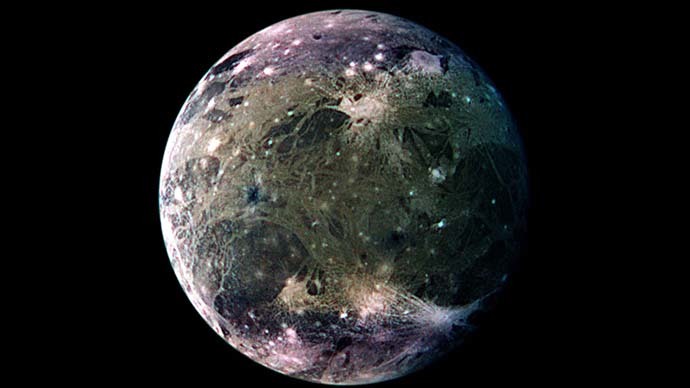Ganymede – the largest moon in our solar system – may possess ice and liquid oceans which scientists say are stacked up like a multi-layered club sandwich and may contain life.
Scientists from a NASA-funded research team performed a computer
modeling of Ganymede's oceans, taking into account for the first
time how salt increases the density of liquids under extreme
conditions that exist on the planet.
Ganymede is the largest moon in our solar system and is bigger
than the planet Mercury, with a diameter of about 5,300
kilometers.
NASA first suspected there might be an ocean on Ganymede in the
1970s. Then, in the 1990s, NASA’s Galileo spacecraft mission flew
by Ganymede, confirming it did have an ocean extending to depths
of hundreds of miles. The Galileo mission also found evidence of
salty seas, which may contain magnesium sulfate.
Scientists then thought Ganymede had a thick ocean sandwich
between just two layers of ice. However, the new research
suggests there may be more layers than that.
The research first appeared last year in the journal Planetary
and Space Science and was led by Steve Vance of NASA’s Jet
Propulsion Laboratory in Pasadena, California.
“Ganymede’s ocean might be organized like a Dagwood
sandwich,” said Vance.

This new theory means that there is the possibility of life on
the icy moon. Previously, the rocky sea bottom of Ganymede was
thought to be coated with ice, not liquid, which would be a
problem for the emergence of life. But the new “club sandwich”
theory means the first layer on top of the rocky core may in fact
be salty water.
Ganymede boasts a lot of water, perhaps 25 times the volume of
the earth’s oceans. The moon's oceans are also estimated to be up
to 800 kilometers deep.
The makeup of its deep oceans could be something like a layer of
ice at the top, a layer of water below that, then a second layer
of ice, followed by another layer of water, then a layer of ice
and a final layer of water at the bottom.
“This is good news for Ganymede. Its ocean is huge, with
enormous pressures, so it was thought that dense ice had to form
at the bottom of the ocean. When we added salts to our models, we
came up with liquids dense enough to sink to the sea floor,”
said Vance.
Salty water sloshing about on top of rock may provide conditions
suitable for microbial life. Some scientists have predicted that
life on Earth may have formed in bubbling thermal vents on the
ocean floor.
Ganymede is just one of five moons in our solar system thought to
support vast oceans hidden beneath icy crusts. The others are
Jupiter’s Europa and Callisto, and Saturn’s Titan and Enceladus.
The European Space Agency is developing a mission to visit
Europa, Callisto, and Ganymede. The mission is currently
scheduled for a 2022 launch, and is expected to reach Jupiter in
2030. NASA plans to contribute instruments to it.

